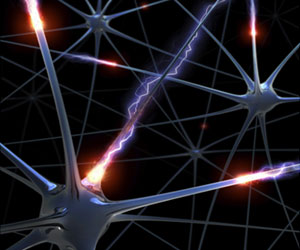
Scientists Uncover New Process Regulating Electrical Firing Properties of Neurons
Neurons in the brain communicate with each other using a combination of carefully regulated chemical and electrical signals. NIH Director’s Pioneer Award recipient Dr. James Eberwine and colleagues at the University of Pennsylvania and Sequenom, Inc. have discovered a novel method by which neurons selectively express proteins that control their electrical properties , reported in the December 7, 2010 issue of the Proceedings of the National Academy of Sciences. In neurons, electrical signals are controlled by channel proteins that create a pore in the cell membrane to allow positively or negatively charged ions to flow in and out of the cell. One of these channel proteins, called BKCa, helps regulate electrical signals in the hippocampus, an area of the brain that is important for learning and memory. Interestingly, the hippocampus is also the focus of many epileptic seizures, which result from disturbances in the electrical firing of neurons. The BKCa channel protein has several different variations. These protein variations arise during a cellular process called “splicing,” which is analogous to the process of cutting an undesired segment out of an audiotape and joining the resulting ends together. To make a protein, a cell must identify the piece of DNA that contains the instructions for the protein (called a gene), copy the DNA into another form of genetic material, called RNA, and then use the information encoded in the RNA to make the protein. Often, the instructions in the DNA for making a protein are not in a continuous stretch, but contain intervening sequences or “introns.” After the DNA is copied into RNA, these introns are removed and the flanking coding sequences, or “exons,” are connected to each other. It is the sequence of merged exons that tells the cell how to make a protein. Since the RNA can be spliced in different ways, one gene sequence can be used to make several different protein variants, depending on which exons are included. Normally splicing takes place in the nucleus of a cell, the cell’s control center where the DNA is stored. However, previous work from Dr. Eberwine’s lab has shown that splicing can also occur outside the nucleus, in a neuron’s cytoplasm. Dr. Eberwine’s latest paper demonstrates for the first time that one of the introns removed during cytoplamic splicing can regulate which form of BKCa channel protein is made, which in turn affects important electrical properties of the neuron. While introns used to be considered “junk DNA,” a number of studies, including Dr. Eberwine’s papers, are demonstrating that introns play crucial regulatory roles. Studying the process of splicing and intron removal in the production of BKCa channels may provide new insights about disorders of neuronal misfiring, such as epilepsy.
Reference:
Bell TJ, Miyashiro KY, Sul JY, Buckley PT, Lee MT, McCullough R, Jochems J, Kim J, Cantor CR, Parsons TD, Eberwine JH. Intron retention facilitates splice variant diversity in calcium-activated big potassium channel populations. Proceedings of the National Academy of Sciences, 2010 Dec 7; 107(49): 21152-7. PMID: 21078998.